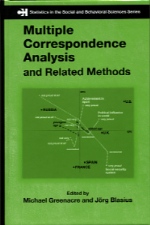General Information
 Quote from the cover:
Quote from the cover:
"As a generalization of simple corresponence analysis, multiple correspondence analysis (MCA) is a powerful technique for handling larger, more complex datasets, including the high-dimensional categorical data often encountered in the social sciences, marketing, health economics, and biomedical research. However, the literature on the subject has been scattered, leaving many in these fields with no comprehensive resource from which to learn its theory, applications, and implementation".
"'Multiple Correspondence Analysis and Related Methods' gives a state-of-the-art description of this new field in an accessible, self-contained, textbook format. Explaining the methodology step-by-step, it offers an exhaustive survey of the different approaches taken by researchers from different statistical 'schools' and explores a wide variety of application areas. Each chapter includes empirical examples that provide a practical understanding of the method and its interpretation, and most chapters end with a 'Software Note' that discusses software and computational aspects. An appendix at the end of the book gives further computing details along with code written in the R language for performing MCA and related techniques. ..."
Further information: Flyer (PDF, approx. 1,2 MB)
Errata
Table of Contents
Section I - Introduction
- Jörg Blasius and Michael Greenacre: "Correspondence Analysis and Related methods in Practice", pp. 3-40
- Michael Greenacre: "From Simple to Multiple Correspondence Analysis", pp. 41-76
- John C. Gower: "Divided by a Common Language: Analyzing and Visualizing Two-Way Arrays", pp. 77-105
- Jan de Leeuw: "Nonlinear Principal Component Analysis and Related Techniques", pp. 107-133
Section II - Multiple Correspondence Analysis
- Henry Rouanet: "The Geometric Analysis of Structured Individuals x Variables Tables", pp. 137-159
- Shizuhiko Nishisato: "Correlational Structure of Multiple-Choice Data as Viewed from Dual Scaling", pp. 161-177
- Ludovic Lebart: "Validation Techniques in Multiple Correspondence Analysis", pp. 179-195
- Michael Greenacre and Rafael Pardo: "Multiple Correspondence Analysis of Subsets of Response Categories", 197-217
- Matthijs J. Warrens and Willem J. Heiser: "Scaling Unidimensional Models with Multiple Correspondence Analysis", pp. 219-235
- Wijbrandt van Schuur and Jörg Blasius: "The Unfolding Fallacy Unveiled: Visualizing Structures of Dichotomous Unidimensional Item-Response-Theory Data by Multiple Correspondence Analysis", pp. 237-258
- Yoshio Takane and Heungsun Hwang: "Regularized Multiple Correspondence Analysis", pp. 259-279
Section III - Analysis of Sets of Tables
- Herbert Matschinger and Matthias C. Angermeyer: "The Evaluation of 'Don't Know' Responses by Generalized Canonical Analysis, pp.283-297
- Jérôme Pagès and Mónica Bécue-Bertaut: "Multiple Factor Analysis for Contingency Tables", pp. 299-326
- Amaya Zárraga and Beatriz Goitisolo: "Simultaneous Analysis: A joint Study of Several Contingency Tables with Different Margins", pp. 327-350
- Elena Abascal, Ignacio García Lautre and M. Isabel Landaluce: "Multiple Factor Analysis of Mixed Tables of Metric and Categorical Data", pp. 351-367
Section IV - MCA and Classification
- Gilbert Saporta and Ndèye Niang: "Correspondence Analysis and Classification", pp. 371-392
- Stéphanie Bougeard, Mohamed Hanafi, Hicham Noçairi and El-Mostafa Qannari "Multiblock Canonical Correlation Analysis for Categorical Variables: Application to Epidemiological Data", pp. 393-404
- Henri Caussinus and Anne Tuiz-Gazen: "Projection-Pursuit Approach for Categorical Data", pp.405-418
Section V - Related Methods
- Anna Torres-Lacomba: "Correspondence Analysis and Categorical Conjoint Measurement", pp. 421-432
- Jörg Blasius and Victor Thiessen: "A Three-Step Approach to Assessing the Behaviour of Survey Items in Cross-National Research", pp. 433-453
- Pieter M. Kroonenberg and Carolyn J. Anderson: "Additive and Multiplicative Models for Three-Way Contingency Tables: Darroch (1974) Revisited", pp. 455-486
- Patrick J.F. Groenen and Alex J. Koning: "A New Model for Visualizing Interactions in Analysis of Variance", pp. 487-502
- José L. Vicente-Villardón, M. Purificación Galindo-Villardón and Antonio Blázques-Zaballos: "Logistic Biplots", pp. 503-521
Appendix
- Oleg Nenadić and Michael Greenacre: "Computation of Multiple Correspondence Analysis, with Code in R", pp. 523-551